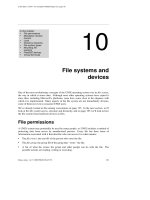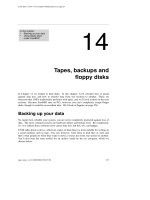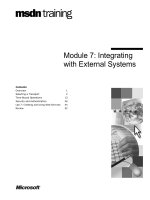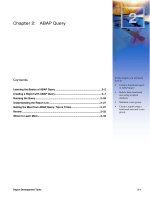Chapter 14 :LAN Systems pdf
Bạn đang xem bản rút gọn của tài liệu. Xem và tải ngay bản đầy đủ của tài liệu tại đây (332.89 KB, 45 trang )
William Stallings
Data and Computer
Communications
Chapter 14
LAN Systems
Ethernet (CSAM/CD)
Carriers Sense Multiple Access with Collision
Detection
Xerox - Ethernet
IEEE 802.3
IEEE802.3 Medium Access
Control
Random Access
Stations access medium randomly
Contention
Stations content for time on medium
ALOHA
Packet Radio
When station has frame, it sends
Station listens (for max round trip time)plus small
increment
If ACK, fine. If not, retransmit
If no ACK after repeated transmissions, give up
Frame check sequence (as in HDLC)
If frame OK and address matches receiver, send ACK
Frame may be damaged by noise or by another station
transmitting at the same time (collision)
Any overlap of frames causes collision
Max utilization 18%
Slotted ALOHA
Time in uniform slots equal to frame
transmission time
Need central clock (or other sync mechanism)
Transmission begins at slot boundary
Frames either miss or overlap totally
Max utilization 37%
CSMA
Propagation time is much less than transmission time
All stations know that a transmission has started almost
immediately
First listen for clear medium (carrier sense)
If medium idle, transmit
If two stations start at the same instant, collision
Wait reasonable time (round trip plus ACK contention)
No ACK then retransmit
Max utilization depends on propagation time (medium
length) and frame length
Longer frame and shorter propagation gives better utilization
If Busy?
If medium is idle, transmit
If busy, listen for idle then transmit immediately
If two stations are waiting, collision
CSMA/CD
With CSMA, collision occupies medium for
duration of transmission
Stations listen whilst transmitting
If medium idle, transmit
If busy, listen for idle, then transmit
If collision detected, jam then cease
transmission
After jam, wait random time then start again
Binary exponential back off
CSMA/CD
Operation
Collision Detection
On baseband bus, collision produces much
higher signal voltage than signal
Collision detected if cable signal greater than
single station signal
Signal attenuated over distance
Limit distance to 500m (10Base5) or 200m
(10Base2)
For twisted pair (star-topology) activity on more
than one port is collision
Special collision presence signal
IEEE 802.3 Frame Format
10Mbps Specification
(Ethernet)
<data rate><Signaling method><Max segment length>
10Base5 10Base2 10Base-T 10Base-FP
Medium Coaxial Coaxial UTP 850nm fiber
Signaling Baseband Baseband Baseband Manchester
Manchester Manchester Manchester On/Off
Topology Bus Bus Star Star
Nodes 100 30 - 33
100Mbps (Fast Ethernet)
100Base-TX 100Base-FX 100Base-T4
2 pair, STP 2 pair, Cat 5UTP 2 optical fiber 4 pair, cat 3,4,5
MLT-3 MLT-3 4B5B,NRZI 8B6T,NRZ
Gigabit Ethernet Configuration
Gigabit Ethernet - Differences
Carrier extension
At least 4096 bit-times long (512 for 10/100)
Frame bursting
Gigabit Ethernet - Physical
1000Base-SX
Short wavelength, multimode fiber
1000Base-LX
Long wavelength, Multi or single mode fiber
1000Base-CX
Copper jumpers <25m, shielded twisted pair
1000Base-T
4 pairs, cat 5 UTP
Signaling - 8B/10B
Token Ring (802.5)
MAC protocol
Small frame (token) circulates when idle
Station waits for token
Changes one bit in token to make it SOF for data
frame
Append rest of data frame
Frame makes round trip and is absorbed by
transmitting station
Station then inserts new token when transmission
has finished and leading edge of returning frame
arrives
Under light loads, some inefficiency
Under heavy loads, round robin
Token Ring
Operation
Token Ring MAC Frame
Priority
Scheme
Dedicated Token Ring
Central hub
Acts as switch
Full duplex point to point link
Concentrator acts as frame level repeater
No token passing
802.5 Physical Layer
Data Rate 4 16 100
Medium UTP,STP,Fiber
Signaling Differential Manchester
Max Frame 4550 18200 18200
Access Control TP or DTR TP or DTR DTR
Note: 1Gbit in development
FDDI
100Mbps
LAN and MAN applications
Token Ring
FDDI MAC Frame Format
FDDI MAC Protocol
As for 802.5 except:
Station seizes token by aborting token
transmission
Once token captured, one or more data frames
transmitted
New token released as soon as transmission
finished (early token release in 802.5)









